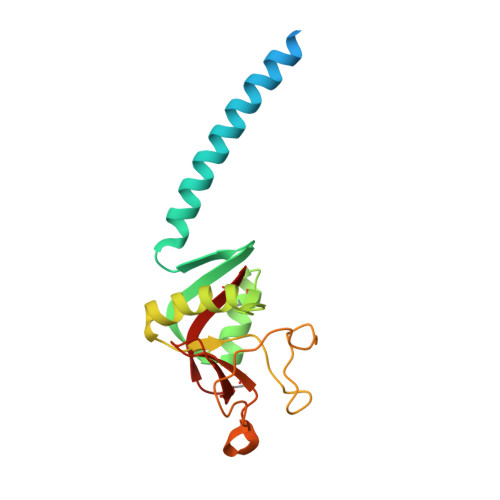High resolution structural insights into ligand binding and immune cell recognition by human lung surfactant protein D
Shrive, A.K., Tharia, H.A., Strong, P., Kishore, U., Burns, I., Rizkallah, P.J., Reid, K.B., Greenhough, T.J.(2003) J Mol Biology 331: 509-523
- PubMed: 12888356
- DOI: https://doi.org/10.1016/s0022-2836(03)00761-7
- Primary Citation of Related Structures:
1PW9, 1PWB - PubMed Abstract:
Lung surfactant protein D (SP-D) can directly interact with carbohydrate residues on pulmonary pathogens and allergens, stimulate immune cells, and manipulate cytokine and chemokine profiles during the immune response in the lungs. Therapeutic administration of rfhSP-D, a recombinant homotrimeric fragment of human SP-D comprising the alpha-helical coiled-coil neck plus three CRDs, protects mice against lung allergy and infection caused by the fungal pathogen Aspergillus fumigatus. The high resolution crystal structures of maltose-bound rfhSP-D to 1.4A, and of rfhSP-D to 1.6A, define the fine detail of the mode and nature of carbohydrate recognition and provide insights into how a small fragment of human SP-D can bind to allergens/antigens or whole pathogens, and at the same time recruit and engage effector cells and molecules of humoral immunity. A previously unreported calcium ion, located on the trimeric axis in a pore at the bottom of the funnel formed by the three CRDs and close to the neck-CRD interface, is coordinated by a triad of glutamate residues which are, to some extent, neutralised by their interactions with a triad of exposed lysine residues in the funnel. The spatial relationship between the neck and the CRDs is maintained internally by these lysine residues, and externally by a glutamine, which forms a pair of hydrogen-bonds within an external cleft at each neck-CRD interface. Structural links between the central pore and the cleft suggest a possible effector mechanism for immune cell surface receptor binding in the presence of bound, extended natural lipopolysaccharide and phospholipid ligands. The structural requirements for such an effector mechanism, involving both the trimeric framework for multivalent ligand binding and recognition sites formed from more than one subunit, are present in both native hSP-D and rfhSP-D, providing a possible explanation for the significant biological activity of rfhSP-D.
- School of Life Sciences, Keele University, Staffordshire ST5 5BG, Keele, UK. a.k.shrive@keele.ac.uk
Organizational Affiliation:

















